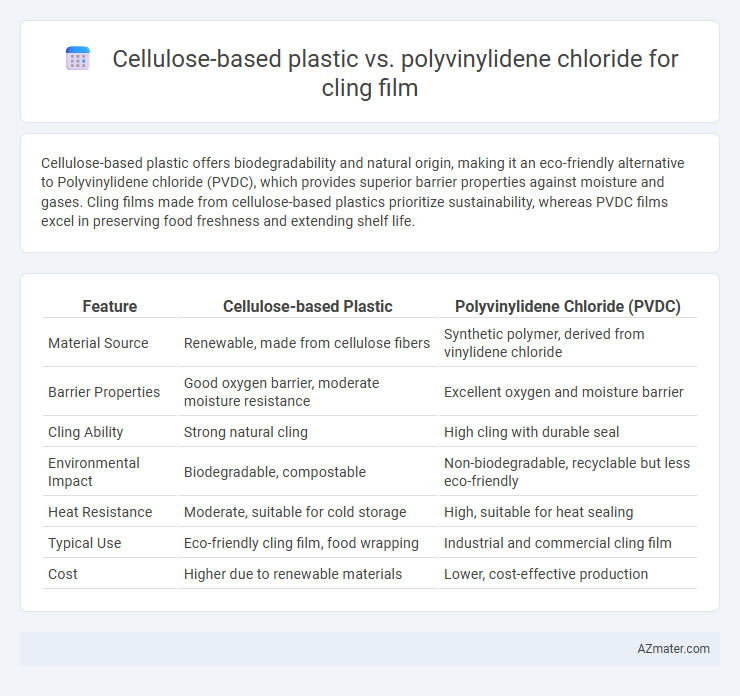Cellulose-based plastic offers biodegradability and natural origin, making it an eco-friendly alternative to Polyvinylidene chloride (PVDC), which provides superior barrier properties against moisture and gases. Cling films made from cellulose-based plastics prioritize sustainability, whereas PVDC films excel in preserving food freshness and extending shelf life.
Table of Comparison
| Feature | Cellulose-based Plastic | Polyvinylidene Chloride (PVDC) |
|---|---|---|
| Material Source | Renewable, made from cellulose fibers | Synthetic polymer, derived from vinylidene chloride |
| Barrier Properties | Good oxygen barrier, moderate moisture resistance | Excellent oxygen and moisture barrier |
| Cling Ability | Strong natural cling | High cling with durable seal |
| Environmental Impact | Biodegradable, compostable | Non-biodegradable, recyclable but less eco-friendly |
| Heat Resistance | Moderate, suitable for cold storage | High, suitable for heat sealing |
| Typical Use | Eco-friendly cling film, food wrapping | Industrial and commercial cling film |
| Cost | Higher due to renewable materials | Lower, cost-effective production |
Introduction: The Evolution of Cling Film Materials
Cellulose-based plastic and polyvinylidene chloride (PVDC) represent two significant materials used in the evolution of cling film, each offering distinct advantages in terms of biodegradability and barrier properties. Cellulose-based films are derived from renewable resources like wood pulp, providing eco-friendly alternatives with excellent oxygen permeability control, while PVDC excels in moisture resistance and gas barrier performance, extending food shelf life. The transition towards cellulose highlights growing environmental concerns, driving innovation in sustainable packaging solutions for cling film applications.
What is Cellulose-Based Plastic?
Cellulose-based plastic is a bio-derived, biodegradable material made from natural cellulose fibers extracted primarily from wood pulp or cotton. It serves as an eco-friendly alternative to conventional plastics like polyvinylidene chloride (PVDC) used in cling films, offering similar transparency and barrier properties without the environmental persistence. This sustainable polymer decomposes more rapidly, reducing plastic pollution and reliance on fossil fuels.
Understanding Polyvinylidene Chloride (PVDC)
Polyvinylidene chloride (PVDC) is a synthetic polymer widely used in cling films due to its superior barrier properties against moisture, oxygen, and aroma, which extends food freshness significantly. Unlike cellulose-based plastics, PVDC offers exceptional chemical resistance and flexibility, making it ideal for packaging perishable goods. Its high density and low permeability contribute to reduced spoilage and enhanced shelf life compared to biodegradable alternatives.
Barrier Properties: Moisture and Gas Permeability Comparison
Cellulose-based plastics exhibit moderate moisture barrier properties but generally allow higher gas permeability compared to polyvinylidene chloride (PVDC), which demonstrates superior moisture and oxygen barrier performance critical for cling film applications. PVDC's low water vapor transmission rate (WVTR) and oxygen transmission rate (OTR) make it highly effective in preserving food freshness by limiting gas exchange and moisture loss. In contrast, cellulose-based films, while biodegradable and renewable, often require coatings or laminates to enhance their barrier properties to compete with PVDC's effectiveness in commercial cling film usage.
Environmental Impact: Biodegradability and Recyclability
Cellulose-based plastic cling film offers superior biodegradability due to its natural origin, breaking down efficiently in composting environments without leaving harmful residues. In contrast, polyvinylidene chloride (PVDC) cling film, derived from synthetic polymers, exhibits low biodegradability and poses recycling challenges, often requiring specialized facilities that limit its environmental sustainability. The recyclability of cellulose-based films is enhanced by their compatibility with organic waste streams, whereas PVDC films contribute to persistent plastic pollution due to their chemical composition and limited recycling infrastructure.
Food Safety and Chemical Migration Risks
Cellulose-based plastic cling films exhibit superior food safety profiles due to their natural origin and biodegradability, minimizing chemical migration risks compared to polyvinylidene chloride (PVDC), which may release harmful chlorinated compounds under heat or prolonged food contact. Studies reveal that PVDC cling films can leach vinylidene chloride monomers and additives, raising concerns about potential toxicity and regulatory limits on migration into food. Cellulose alternatives, often derived from renewable resources and free of chlorine, ensure safer packaging solutions by reducing exposure to volatile organic compounds and enhancing compliance with stringent food safety standards.
Mechanical Strength and Clarity Analysis
Cellulose-based plastic cling films exhibit excellent mechanical strength with high tensile properties and good tear resistance, making them durable for food wrapping applications. Polyvinylidene chloride (PVDC) films offer superior clarity due to their smooth surface and low haze, enhancing product visibility and consumer appeal. While PVDC excels in transparency, cellulose-based films provide a better balance of mechanical durability and eco-friendliness in cling film usage.
Cost and Commercial Availability
Cellulose-based plastic cling films typically incur higher production costs due to the complexity of sourcing and processing natural fibers, limiting their widespread commercial availability primarily to niche markets focused on sustainability. Polyvinylidene chloride (PVDC) cling films offer lower manufacturing expenses and greater commercial availability, making them the preferred choice for large-scale food packaging despite environmental concerns. The cost-effectiveness and well-established supply chains of PVDC contribute to its dominance in the cling film market, whereas cellulose-based alternatives remain a premium option with limited distribution.
Consumer Preferences and Market Trends
Consumer preferences for cling film are increasingly shifting toward cellulose-based plastics due to their biodegradability and eco-friendly attributes, aligning with growing environmental concerns. Polyvinylidene chloride (PVDC) cling films maintain popularity for superior barrier properties against moisture and gases, ensuring extended food freshness, but face scrutiny for limited recyclability and chemical production processes. Market trends indicate rising demand for sustainable packaging solutions, driving innovation and adoption of cellulose-based options while PVDC products sustain niche applications where performance outweighs environmental impact.
Future Prospects for Sustainable Cling Film Solutions
Cellulose-based plastics offer a biodegradable and renewable alternative to conventional cling films made from polyvinylidene chloride (PVDC), addressing environmental concerns related to plastic waste accumulation. Advances in cellulose functionalization and nanocomposite integration enhance barrier properties, making cellulose films increasingly competitive with PVDC in terms of moisture and oxygen resistance. The scalable production of cellulose films from sustainably sourced biomass positions them as a promising candidate for future cling film solutions aligned with circular economy principles and reducing reliance on fossil-fuel-derived polymers.

Infographic: Cellulose-based plastic vs Polyvinylidene chloride for Cling film
 azmater.com
azmater.com